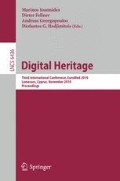Abstract
Modern high resolution 3D-measuring techniques are widely used in quality control and industrial production, because they allow precise and reliable inspection of objects. Their potential to monitor surfaces, however, must not be restricted to industrial objects. Also in cultural heritage applications a detailed and reliable spatial description of surfaces is often useful and opens up new possibilities for conservation, analysis or presentation of objects.
In the actual work we have considered Buddhistic stone inscriptions (8th-12th centuries) which are important cultural assets of China. They need to be documented, analyzed, interpreted and visualized archaeologically, art-historically and text-scientifically. On one hand such buddhistic stone inscriptions have to be conserved for future generations but on the other hand further possibilities for analyzing the data could be enabled when the inscriptions would be accessible to a larger community, for instance the understanding of the historical growth of Buddhism in China.
In this article we show innovative techniques for the documentation and analysis of stone inscriptions located in the province of Sichuan - south-west of china. The stone inscriptions have been captured using high precision 3D-measuring techniques what produces exact copies of the original inscriptions serving as base for further processing tasks. Typical processing might be directed towards an improvement of the legibility of characters or may try to automatically detect individual letters, to automatically identify certain text passages or even to characterize the written elements with respect to a potential style of the monk or the executing stonemason. All these processing steps will support the interpretation of the inscriptions by the sinologists involved with the analysis and evaluation of the texts. The concept and features of the image processing applied on the captured inscription as well as the aims and the effect of an interpretation based on algorithms for identifying and analyzing the inscriptions are demonstrated. In order to present the outcome to a large community, the results of the stone inscription reconstruction, the done interpretation and additional 2D / 3D maps are published within an interactive web platform.
Access this chapter
Tax calculation will be finalised at checkout
Purchases are for personal use only
Preview
Unable to display preview. Download preview PDF.
References
Ledderose, L.: The Stones resembled printing blocks. The engraved Buddhist stone scriptures at Yúnjū monastery of Fāngshan and the Qìdān canon. In: Anderl, C., Eifring, H. (eds.) Studies in Chinese Language and Culture, pp. 319–329. Hermes Publishing, Oslo (2006)
Ledderose, L.: Rubbings in Art History. In: Walravens, H. (ed.) Catalogue of Chinese Rubbings from Field Museum, Field Museum of Natural History, Chicago, USA. Fieldiana Anthropology New Series, vol. 3, pp. XXVIII–XXXVI (1981)
Boochs, F., Heinz, G., Huxhagen, U., Müller, H.: Digital Documentation of Cultural Heritage Objects using hybrid recording techniques. In: Ioannides, M., Niccolucci, F., Mania, K. (eds.) The e-volution of Information Communication Technology in Cultural Heritage. part 2, pp. 258–262. EPOCH Publishing, Nicosia (2006)
Böhler, W., Bordas Vicent, M., Heinz, G., Marbs, A., Müller, H.: High Quality Scanning and Modeling of Monuments and Artifacts. In: Proceedings of the FIG Working Week 2004, Athens, Greece, May 22-27. FIG (2004)
Hanke, K., Böhler, W.: Recording and Visualizing the Cenotaph of German Emperor Maximilian I. In: Int. Archives of Photogrammetry & Remote Sensing, vol. XXXV, B5 (2004)
Hoffmann, A., Huxhagen, U., Welter, D., Boochs, F.: Digital reconstruction archaeological objects using hybrid sensing techniques - the example Porta Nigra. In: 2nd International Conference on Remote Sensing Archaeology, Rome, Italy (2006)
Malzbender, T., Gelb, D., Wolters, H.: Polynomial texture maps. In: Proceedings of SIGGRAPH 2001 Computer Graphics, pp. 519–528 (2001)
Schmidt, N., Schütze, R., Boochs, F.: 3D-Sutra - Interactive Analysis Tool for a Web-Atlas of Scanned Sutra Inscriptions in China. In: Proceedings of the ISPRS Commission V Mid-Term Symposium Close Range Image Measurement Techniques, Newcastle upon Tyne, United Kingdom (2010)
Steinke, K.-H.: Lokalisierung von Schrift in komplexer Umgebung. In: Tagungsband der Jahrestagung der deutschen Gesellschaft für Photogrammetrie, Jena, Germany, pp. 165–173 (2009)
Schmidt, N.: 3D-Sutren - Konzeptionierung und Entwicklung eines Prozessierungsmoduls und einer Webapplikation für den Anwendungsbereich Sinologie. Master thesis, FH Mainz (2009) (unpublished)
Derpanis, K.G.: The Harris corner detector. York University (2004), http://www.cse.yorku.ca/~kosta/CompVis_Notes/harris_detector.pdf (accessed May 28, 2010)
Author information
Authors and Affiliations
Editor information
Editors and Affiliations
Rights and permissions
Copyright information
© 2010 Springer-Verlag Berlin Heidelberg
About this paper
Cite this paper
Schmidt, N., Boochs, F., Schütze, R. (2010). Capture and Processing of High Resolution 3D-Data of Sutra Inscriptions in China. In: Ioannides, M., Fellner, D., Georgopoulos, A., Hadjimitsis, D.G. (eds) Digital Heritage. EuroMed 2010. Lecture Notes in Computer Science, vol 6436. Springer, Berlin, Heidelberg. https://doi.org/10.1007/978-3-642-16873-4_10
Download citation
DOI: https://doi.org/10.1007/978-3-642-16873-4_10
Publisher Name: Springer, Berlin, Heidelberg
Print ISBN: 978-3-642-16872-7
Online ISBN: 978-3-642-16873-4
eBook Packages: Computer ScienceComputer Science (R0)

